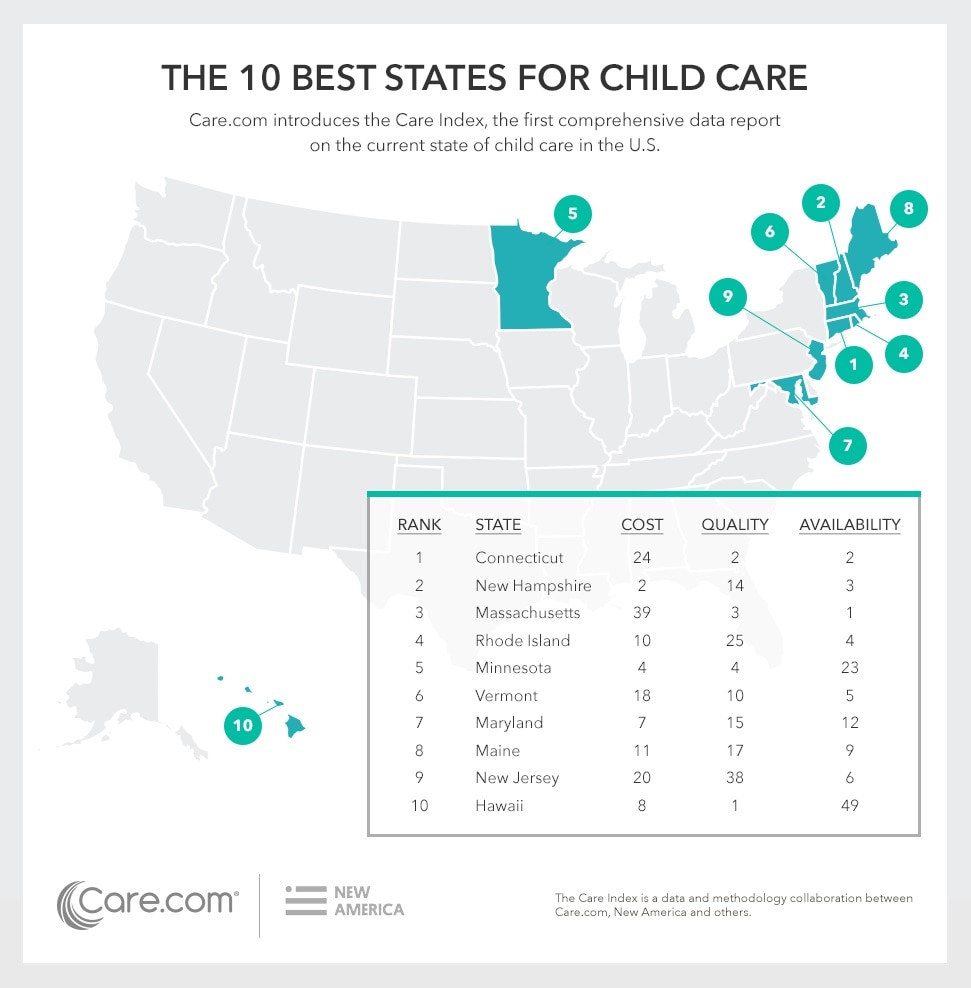This week, Care.com introduced the Care Index, the first comprehensive data report on the current state of child care in the U.S., which ranks states based on quality, affordability and availability.
The big question is: where does your state rank?
With the average cost of child care coming in at about $18,000 per year — equivalent to the national average housing cost — new parents are in for a rude awakening when they look into child care centers and nannies.
[RELATED: “Want to Raise a Child? That’ll Cost You $233,610“]
And when it comes to quality and availability, they are often faced with an even more difficult reality.
Map of the Top Ten States for Child Care

Care.com analyzed how each state ranks when it comes to child care cost, quality and availability. Providing equal weight to all three qualifying factors, the Care Index shows that even in the best states, families face trade-offs when searching for low-cost, high-quality child care that’s available when they need it.
Child Care Ranking of All 50 States
When it came to the best in the country, the East Coast — and specifically the Northeast — fared the best, while many southern states ranked near the bottom.
|
Rank |
State |
Cost |
Quality |
Availability |
| 1. |
Connecticut |
24 |
2 |
2 |
| 2. |
New Hampshire |
2 |
14 |
3 |
| 3. |
Massachusetts |
39 |
3 |
1 |
| 4. |
Rhode Island |
10 |
25 |
4 |
| 5. |
Minnesota |
4 |
4 |
23 |
| 6. |
Vermont |
18 |
10 |
5 |
| 7. |
Maryland |
7 |
15 |
12 |
| 8. |
Maine |
11 |
17 |
9 |
| 9. |
New Jersey |
20 |
38 |
6 |
| 10. |
Hawaii |
8 |
1 |
49 |
| 11. |
Virginia |
12 |
26 |
10 |
| 12. |
Wyoming |
3 |
5 |
44 |
| 13. |
Delaware |
14 |
39 |
7 |
| 14. |
Pennsylvania |
21 |
19 |
13 |
| 15. |
Iowa |
6 |
9 |
34 |
| 16. |
North Dakota |
1 |
49 |
24 |
| 17. |
Colorado |
25 |
27 |
16 |
| 18. |
Georgia |
31 |
13 |
14 |
| 19. |
Florida |
30 |
18 |
15 |
| 20. |
Missouri |
22 |
16 |
27 |
| 21. |
Nebraska |
5 |
48 |
28 |
| 22. |
Michigan |
19 |
43 |
18 |
| 23. |
Wisconsin |
15 |
40 |
22 |
| 24. |
South Carolina |
34 |
7 |
20 |
| 25. |
North Carolina |
40 |
12 |
11 |
| 26. |
Idaho |
9 |
11 |
46 |
| 27. |
Oregon |
29 |
29 |
25 |
| 28. |
Illinois |
37 |
28 |
17 |
| 29. |
Washington |
33 |
33 |
19 |
| 30. |
Montana |
17 |
41 |
32 |
| 31. |
Texas |
16 |
45 |
38 |
| 32. |
Indiana |
36 |
6 |
33 |
| 33. |
Arkansas |
28 |
24 |
42 |
| 34. |
California |
32 |
31 |
31 |
| 35. |
Kansas |
27 |
35 |
36 |
| 36. |
South Dakota |
23 |
32 |
45 |
| 37. |
Alabama |
41 |
8 |
29 |
| 38. |
Utah |
13 |
37 |
48 |
| 39. |
New York |
45 |
42 |
8 |
| 40. |
Ohio |
35 |
47 |
21 |
| 41. |
Arizona |
38 |
30 |
43 |
| 42. |
Louisiana |
44 |
22 |
40 |
| 43. |
Kentucky |
42 |
34 |
30 |
| 44. |
Tennessee |
47 |
21 |
26 |
| 45. |
Alaska |
26 |
46 |
50 |
| 46. |
Oklahoma |
43 |
44 |
39 |
| 47. |
Nevada |
48 |
36 |
41 |
| 48. |
New Mexico |
46 |
20 |
47 |
| 49. |
Mississippi |
49 |
23 |
35 |
| 50. |
West Virginia |
50 |
50 |
37 |
Takeaways
So what should parents do if they don’t feel that the quality of their child care is up to par? Or if their state didn’t make the Care.com Top 10 List?
If you have reason to believe your child care isn’t sufficient, especially in terms of quality, it’s important to make a change.
Here are some suggestions:
- Look for locally approved N.A.E.Y.C. and N.A.F.C.C. child care centers.
- Get on community message boards and ask friends for their local suggestions. Really dig into why they love their center.
- Discuss your concerns with your child care center and see how you and some other parents might be able to initiate change. Take a list of concerns and suggestions to the center director. A large group of concerned parents can make a big difference. You can even start a private message board to discuss your center in the Care.com community.
- Create a “dream nanny” job description and send it out to friends and neighbors, and post it on Care.com. Add the hourly rate that you’re comfortable paying, and see who applies. The idea behind a site like Care.com is that people who aren’t interested won’t apply.
- If the cost of a nanny is too high, consider a nanny share, in which two families pay for one nanny, thus cutting their care costs in half.
> 7 questions to ask when touring a day care center
> 8 signs of a bad day care center
> 5 must-have nanny qualifications
Methodology
The Care Index is a ranking of all 50 states based on the cost, quality and availability of paid child care in each state, combining both in-home caregiving and child care center data. For more information on how cost, quality and availability are determined, go to Care.com/care-index.
The Care Index draws on unique proprietary data from Care.com member job postings and caregiver reviews, as well as publicly available data from the US Census Bureau, Bureau of Labor Statistics, the National Association for the Education of Young Children (NAEYC) and the National Association for Family Child Care (NAFCC). A survey conducted by Care.com and New America in October 2015 provides additional data on paid child care arrangements in each state among households with children.
Want to check out more of our studies? Feel free to peruse this list:
- The 20 Most Family-Friendly Cities for Halloween in 2016
- The 10 Best Cities in America to Raise the Next Rock Star
- The Best — and Worst — States for Child Care
- Dads Are Getting More Involved on Valentine’s Day — By the Numbers
- Grab Your Pup’s Leash: These Are the Best U.S. Cities for Walking Your Dog
- How Child Care Could Swing the Election
- How Much Do the Holidays Cost?
- Listen up, College Kids: Here Are the Top 20 Cities to Make Bank Over Break
- Want a New You in the New Year? Here’s Where You’re Most Likely to Make That Happen in 2017




